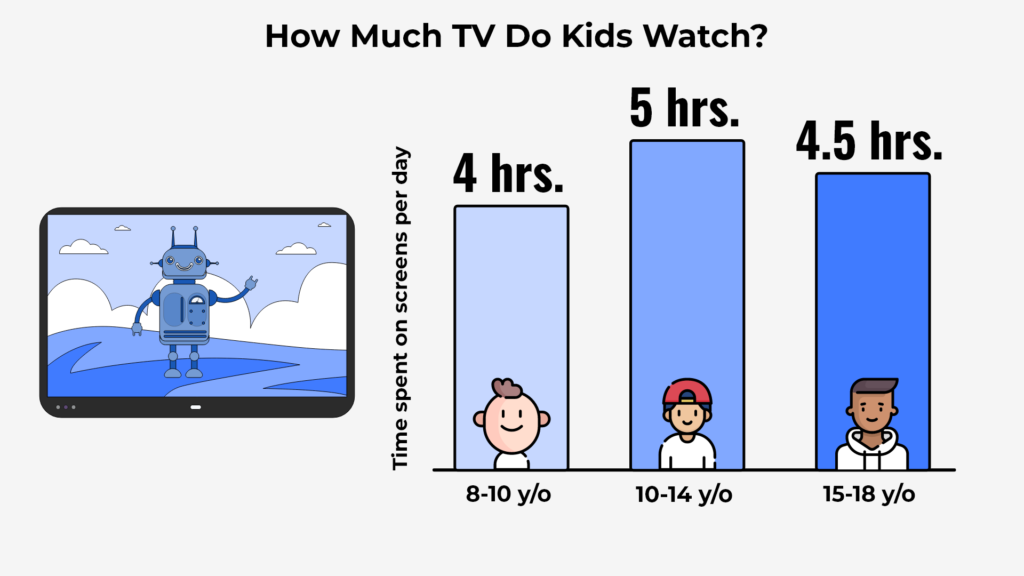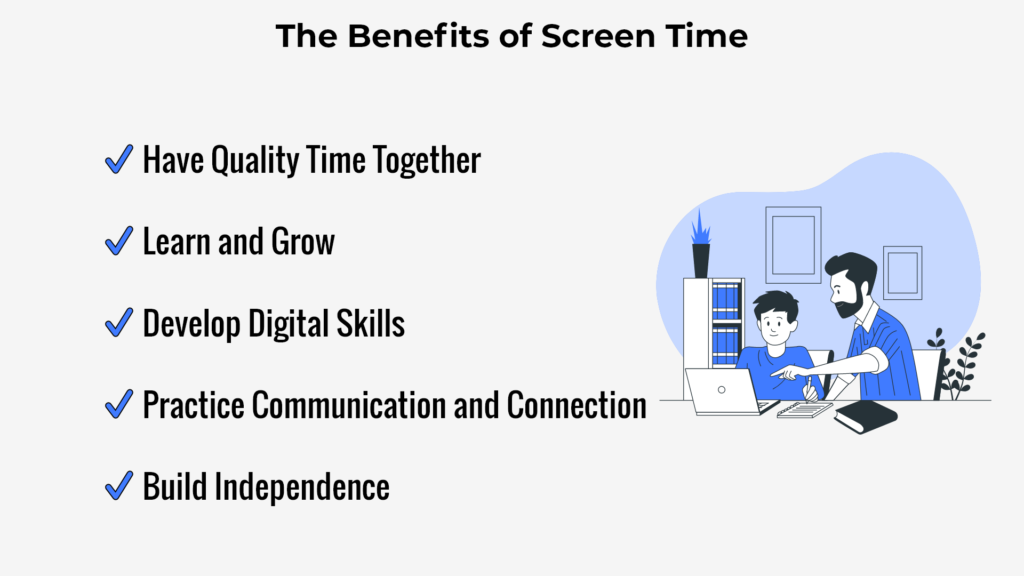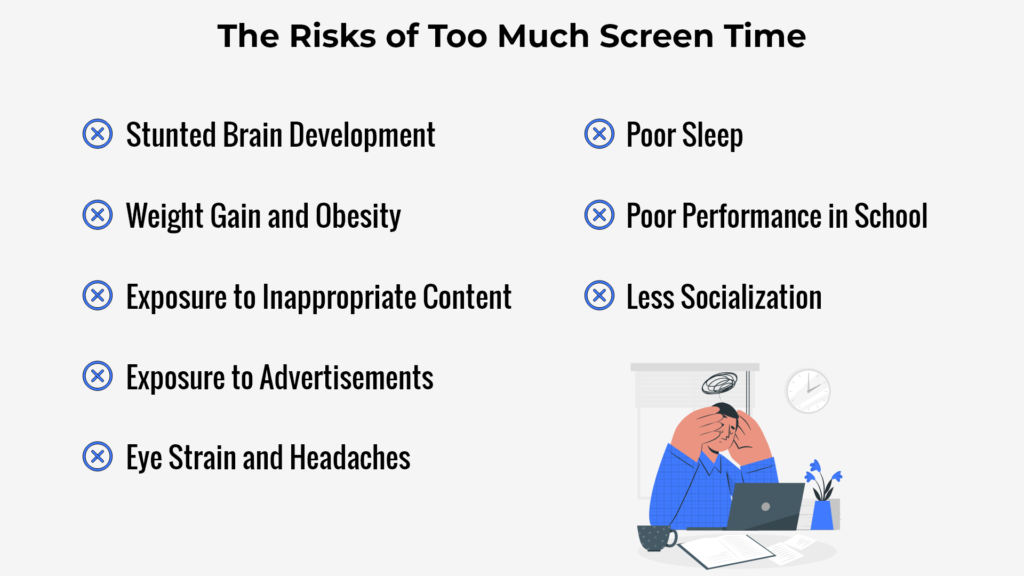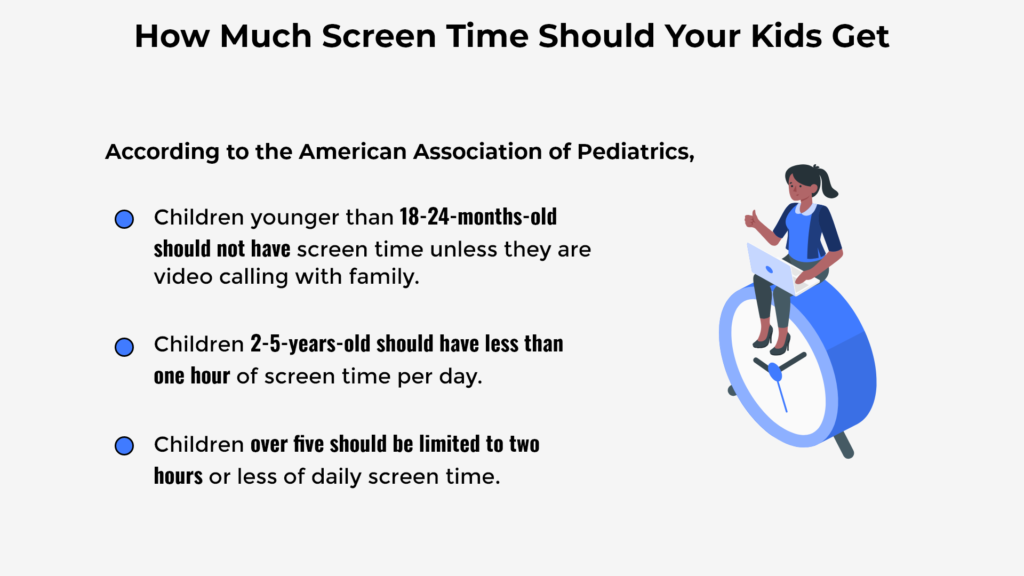Children and Screen Time: How Much is Too Much?
Written and submitted by Cable Compare
It’s hard to go anywhere in this world without looking at a screen. With so many digital devices out there – from phones and tablets to computers and TVs – there is always something to look at. For children specifically, the temptation to stare at a screen is often too hard to resist, leading to unhealthy habits.
Of course, all of this technology is still so new that we don’t really know the impacts of all this screen time. As adults, we can intuitively sense that limiting screen time is a good idea. After all, most of us spend our days in front of computers at work, and we all know how taxing this can be.
When it comes to children, though, the stakes are higher. Their brains are still developing, and they are also learning a whole host of other skills vital for them to succeed in this world. Therefore, it’s critical that we understand the risks of too much screen time, how much is too much, and what we can do to keep things reasonable.
Below we’ve covered all of this and more so that you can be sure you’re doing everything possible to help your child develop healthy screen habits.
How Much Time Do Kids Spend Looking at Screens?
The amount of time children spend on screens depends on age. Here’s a breakdown of just how much screen time kids are getting today using data provided by the CDC and New York-Presbyterian:

- Children under 8 spend 2.25 hours per day in front of screens.
- Children aged 8-10 spend around six hours per day in front of screens.
- Kids between 11 and 14 spend roughly 9 hours per day with screens, five watching television.
- Teenagers 15-18 years old are in front of screens for around 7.5 hours per day.
Interestingly, the 11-14 age bracket has the most screen time of all the groups. It’s likely that older children, those aged 15-18, spend less time in front of screens because they have more options. Kids start driving during this time, and they begin to build their own social lives. However, despite this, they still get a lot of screen time during the day.
One other interesting thing to note is that half of all kids under the age of 8 have their own tablet device. This helps explain why screen time increases as kids get older. They are introduced to these devices at a young age and then, over time, develop an increased dependency on them.
The numbers above refer to the total amount of screen time kids get. Now, let’s dig a bit deeper and see how much of this time is spent watching television:

- 8-10 – 4 hours
- 10-14 – 5 hours
- 15-18 – 4.5 hours
Again, time spent watching TV tapers off as kids get older, but not by much. So, what this means is that most of children’s screen time actually comes from watching television.
Is this good or bad? If you were born in the analog era, then your gut instinct is probably “yes,” but it’s not quite that obvious. There are some reasons why screen time is a good thing. However, the question remains: is it too much?
The Benefits of Screen Time
While most of us are primarily concerned with our children getting too much screen time, cutting things back to zero isn’t always the best idea. There are some genuine benefits to screen time, and recognizing them is an essential first step to ensure your kids are getting the right amount. Here are the most significant to keep in mind:

-
Time With Your Children
The number one thing you can do to help your kids grow in a healthy way is to spend time with them. Not only does this strengthen the bond between you, but it also helps them establish a strong sense of safety and security, which is essential for them to take risks and grow as they get older.
Of course, there are many ways to spend time with your kids, not using screens. Yet, sitting with them and playing a game, reading an interesting article, or watching a TV show still counts as quality time together, especially when whatever you’re doing is educational.
Plus, when you sit with your children while they are using a screen, you get the chance to see how they behave with these devices and teach them about how what they are watching/doing relates to the real world.
Screen time should be one small part of the quality time you spend with your kids, but when done correctly, it can be a fun activity that helps strengthen the family dynamic and encourages kids’ growth.
-
Learning and Development
One of the best parts about the digital age is that we have so much information available to us pretty much at a moment’s notice. All we need to do is pull out our phones or tablets, and we’ve got access to so much.
For kids, this is truly wonderful. It provides them with an infinite resource for learning and growing. It also allows them to independently pursue whatever piques their curiosity, which can help them develop into lifelong learners.
However, for this to work, kids need some help. They can be easily distracted, or they might not know how to look up what interests them. Sitting with them and helping them figure out how the internet works can be a great way to encourage learning and help your child grow.
-
Develop Digital Skills
We live in a digital world, and this isn’t likely to change any time soon. To succeed in school and later in life, you need to have a high digital literacy level, meaning you need to know how these devices work and how to best use them to your advantage.
Children seem to understand digital technology rather intuitively. Introducing them to more and more devices will help them better prepare themselves to use the tools they will likely use when they grow up and start their careers.
This development doesn’t happen on its own. Sitting in front of the TV for hours does not encourage the development of digital skills. Instead, kids need guidance, and exposure to new tools, both of which you as the parent can provide.
-
Communication and Connection Building
Smart devices have rapidly become our primary means of communicating with one another. Whether it’s through text messages, video calls, or social media, it seems that most of our connection these days has some digital component.
For kids, having access to these technologies allows them to develop their own social lives more so than they ever could before by giving them the means to talk with friends and family whenever they want.
Of course, kids can take this too far and put themselves at risk by communicating with strangers. By educating them on the dangers and encouraging good habits, talking through a screen can help kids grow socially.
-
Build Independence
One of the primary things we must do as parents is to help our children learn how to stand for themselves in the world. This involves many things, but screens can play a role. By giving your kids access to these tools, they can explore their own interests, learn about what makes them curious, talk with other people, and more. When they can do this on a device that is “theirs” or at least feels this way, it helps encourage their sense of autonomy and independence.
As parents, it’s not always easy to embrace this, as it just reminds us of how someday our kids will move on and form their own lives. Yet, it’s a critical skill, and when done correctly, kids can partly learn it through screen time.
The Risks of Too Much Screen Time
As you can see, screen time isn’t all doom and gloom. There are reasons why it can be good, but as you likely know, too much screen time can also have some adverse effects on your child. Here are some of these impacts so that you can see why it’s so important to help your kids develop healthy habits.

-
Brain Development
“Stop watching TV! It’ll turn your brain to mush!”
Surely you’ve heard some version of this statement uttered either by yourself, your parents, or parents you know.
It’s easy to see why someone might say this. We all know how we feel after spending way too much time in front of the TV. But is there any reason to believe this is really happening?
Well, it’s unclear. Screens aren’t turning our brains to “mush,” but there is some evidence that they can interfere with your child’s brain development. For example, this study found that children with more than two hours per day on screens scored lower on language and thinking tests.
The same study also found that kids who spend more than seven hours per day on a screen experienced a thinning of the brain’s cortex, which is the part that is responsible for critical thinking and reasoning.
This sounds terrifying, especially when we refer back to the data about how much time kids spend on screens, but we should note that there is still a lot we don’t know. Not enough time has passed to assess the long-term effects of screens on children’s brain development. This research shows us there is at least a reason to be concerned but doesn’t give us the full picture.
-
Screen Time and ADHD
Another study found that kids who spent more than two hours per day in front of a screen were 7.7 times more likely to meet the criteria for an attention deficit hyperactive disorder (ADHD) diagnosis.
To be clear, the link between screen time and ADHD remains weak, and most still believe genes play the most prominent role. However, studies like these do suggest that limiting screen time can be positive for your kids.
All in all, the answer to the question, “do screens turn your brain to mush?” is “probably not,” but they can have an impact on your child’s development. You owe it to them to make sure you’re putting them in the best position to grow and be healthy.
-
Weight Gain and Obesity
Another primary concern of too much screen time is that it can lead to weight gain and obesity. It’s not the screens themselves that can produce this result. Instead, it’s what kids are doing while they are on screens – nothing – that is the issue.
Regular exercise is an essential part of overall health and wellness, no matter how old you are, but it’s vital for kids. If they’re sat in front of a screen for nine hours a day, it’s unlikely they are spending much time outside running around.
Kids should get at least 60 minutes of physical activity per day, and if spending time in front of screens is preventing this from happening, something does need to change.
-
Inappropriate Content
If a kid is spending 5-9 hours per day, are you sitting with them for that whole time to see what they are watching/doing? We’re guessing probably not. With so much time to explore content, it’s all too easy for kids to find content that’s not appropriate for them.
This includes pornography and violent images, but it can also apply to other things. For example, kids may decide to research a topic using poor sources, which can negatively shape their views and opinions, especially when the information presented is inaccurate.
Your child may be using all of their screen time to learn and communicate, but the reality is that the more time they spend on their devices, the more likely they are to stumble across something that isn’t suitable for them.
-
Advertisements
Advertising and screens go hand-in-hand. You pretty much can’t look at one without being exposed to some marketing content.
In theory, this isn’t a bad thing. For young kids who are still learning about the world, all this advertising can be detrimental.
For example, food companies openly market to kids, and the products they advertise are often high in sugar, salt, and fat. When kids spend too much time on screens being exposed to this content, they are more likely to crave these foods, leading to an unhealthy diet and contributing to weight gain and obesity.
Excessive advertising can also be problematic when it comes to a kid’s self-esteem. Pretty much all advertising is based around one idea – you’re not good enough as you are. All the messages sent via ads say that you need to be thinner, have a brighter smile, look a certain way, drive a particular car, live in a specific type of home, and so on.
For adults who are more secure with themselves, they can look past all of this (usually), but kids are far more susceptible. They can easily see what’s on TV and compare themselves to it, leading them to develop poor self-esteem and body image issues.
This doesn’t happen automatically, so making sure kids understand what advertisements are and how to avoid their lure is critical to helping them develop healthy screen habits.
-
Eye Strain and Headaches
Anyone who works in an office knows that, after a while, it just hurts to keep looking at a screen. Sometimes it’s the neck or the back, resulting from poor posture, but it’s often the eyes and the head. Too much time in front of a screen can make your eyes hurt, causing you to strain. This can harm your vision over time. Also, many people report getting a headache after spending a long time in front of a screen.
Kids who are glued to their screens are likely experiencing these things, but they often won’t say anything, and this can cause problems to get worse.
-
Poor Sleep
Sleep is the cornerstone of good health. While we sleep, our bodies and brains get the rest they need to continue with our lives.
Too much screen time can interfere with sleep in several ways. First, if a child has a TV in their room, the noises and lights can keep them up, either intentionally or not, and this can cut into their sleep time.
Even if kids don’t watch TV in their room, using a screen before bed can still be harmful. The blue light emitted from modern screens can mess with our brains. In essence, it confuses it into thinking that it’s still daylight, and this can disrupt the circadian rhythm and lead to sleep problems.
The best thing to do is to make sure all screens are off at least one hour before bed and that kids don’t have access to a screen when they are alone in their rooms.
-
Poor Performance in School
Excessive screen time can also interfere with a child’s ability to perform in school. For example, if a kid is staying up late every night watching TV and not getting enough sleep, their ability to pay attention and function in school will diminish.
Even if kids aren’t watching screens before bed, they can still impact performance in school. It’s a simple question of time. If kids are spending 9 hours a day in front of a screen, five of which are spent in front of the TV, this is time not being dedicated to school.
Schoolwork may require screen time, but this must be included in overall screen time so that kids don’t go overboard and suffer the consequences.
-
Less Socialization
Lastly, while we said earlier that screen time could help kids stay connected with friends and develop their social lives, it can also have the opposite effect. Time in front of a screen is time not spent with other humans, which can be problematic. Your child may be missing out on valuable time they could spend making friends and developing their social skills.
It’s important that kids find ways to socialize in person. While communicating online is good, it’s missing many “real” communication elements, such as body language, tone, mood, etc.
Extreme amounts of screen time mean kids don’t get this experience, making things challenging for them moving forward.
How Much Is Too Much Screen Time?

As you can see, there are quite a few reasons why it’s essential to limit your child’s screen time. While it’s true the data remains inconclusive, there is enough research out there, as well as anecdotal evidence, to suggest that preventing your child from spending too much time on a screen is a good idea.
So, then, how much is too much screen time?
This is a good question, and it’s one we’re still answering. However, based on the research that’s out there, the American Association of Pediatrics recommends keeping kids younger than 18-24 months away from screens entirely. The only exception is for video chatting with family, which can help kids build bonds with family and practice language skills.
For kids between 2-5-years-old, the AAP suggests keeping screen time to one hour per day or less.
After that, the general recommendation is to keep screen time to less than two hours per day. This isn’t always possible in today’s world, especially with so many activities currently taking place online. Older children may need to spend more time in front of screens, but they should also have a better awareness of managing their time on screens and what to do when they feel they are getting too much.
With most things in parenting, it’s important to remember that there is no “one size fits all” approach. Instead, you will need to work out what makes the most sense for you and your child. Use these guidelines while doing this to make sure whatever plan you do create conforms as best as possible to modern medical advice.
How to Spot If Your Kid is Getting Too Much Screen Time
As we said, there isn’t one rule for how much screen time your kids should get. Yes, little children should be limited the most, but it’s often hard to do this with older kids, especially when school requires them to use computers and other tablets.
In addition to limiting screen time, it’s also important you look for some of the signs that your kid is spending too much time in front of a screen. Here are some things to look for that indicate it might be time to cut back:
- Lack of sleep or difficulty sleeping
- Poor physical health
- Disinterest in school
- Isolation from friends and family
- Lack of curiosity for other hobbies or interests
Of course, even if your child isn’t exhibiting these symptoms, they may be getting too much screen time, so keep an eye out for changes in their behavior or health to see if you need to make an adjustment.
How to Limit Screen Time in Your Home
While we may not know the exact impacts of screen time or how much is too much, we can all agree that limiting it as much as possible is a good idea.
Now, anyone with kids knows that this is much easier said than done, but remember, you’re the adult. You can do this!
To help you get started, here are some things you can and should do to try and limit the amount of screen time your kids get:
-
Start With a Conversation
The first thing is to have a conversation. Arbitrarily imposing rules on your kids can cause all sorts of problems, and they are less likely to buy into them if they don’t understand why they are being put in place.
During this conversation, ask them about their screen habits. Ask what they do when they’re on a device, how much they think is too much, and why it’s important to limit screen time. Also, remind them that using a screen for fun is a privilege and not a right. Just because the device exists doesn’t mean they get to use it whenever they want. They must earn it.
They may not initially understand, especially if it means they get to use their tablet less or watch less TV. By starting with a conversation, you can lay the groundwork for whatever policy you’re going to implement, which increases the chances it will be accepted and followed.
-
Create a Screen Policy
Perhaps the best thing you can do to help your kids develop healthy screen habits is to create a screen policy. Things to put in a screen policy include:
Time limits for non-school-related screen activities. These can be daily or weekly, depending on what works best for you and your family.
- Restrictions on when and where kids can use devices.
- Windows of time when screens can’t be used (before bed, during meals, during certain hours, etc.)
- Types of content that are appropriate.
- Stipulations for screen use, such as when homework is done or after they’ve gone outside.
- Consequences for breaking the policy. For example, ignoring the policy could lead to a loss of screen privileges for the following day.
Your screen policy’s specifics will vary based on you and your family, but if you include these elements, you are well on your way to helping your kids develop good screen habits.
-
Keep Devices Public
Kids often end up in front of screens for too long because they have unsupervised access to devices. Maybe they have their own device, or they have a TV in their room, or they know how to get a device without anyone looking.
No matter the case, an excellent way to combat this is to make all devices public. Keep computers and tablets in common areas, and limit the number of TVs kids have access to.
This will make it harder for them to lose hours and hours in front of a screen, but it will also make it easier for you to keep tabs on their screen time and what they are doing when they are online.
-
Use Parental Controls
Although not always the best option, you can use parental controls. These are available on all devices, as well as on your internet and cable service.
With these controls, you can put limits on what types of content your kids can access, and you can also restrict kids’ ability to use a device.
Typically, kids don’t respond well to this type of approach. So, we recommend you try other things first. However, if you’re having a hard time getting a handle on your kids’ screen time, parental controls can be very effective.
Develop Healthy Screen Habits
Based on all the information we have, we can say that screen time isn’t going to kill us. When used in moderation, screens can have a positive impact on our lives. However, that’s the key – moderation.
The numbers we currently have suggest kids are not using these devices in moderation, and the long-term effects of this behavior are yet to be seen.
Therefore, the best thing you can do is to start helping your kids develop healthy screen habits so that they can reap the benefits of digital technology without sacrificing their long-term health and well-being.
This article was submitted and republished, with permission from Cable Compare: https://www.cablecompare.com/blog/children-and-screen-time
Cablecompare.com is the #1 exploration and audit site for internet and TV services in the United States. We are a free tool that permits all Americans to discover what the best internet and TV providers are in their location.



